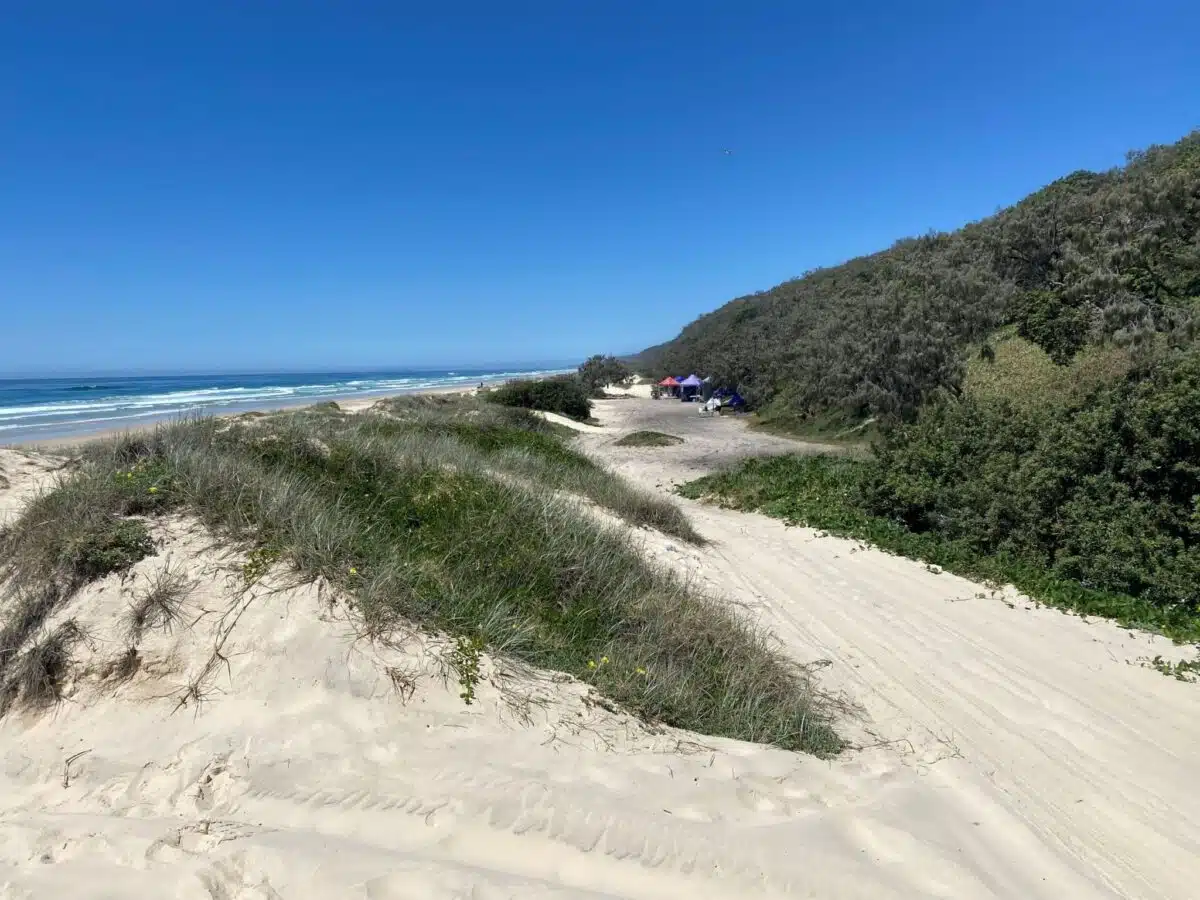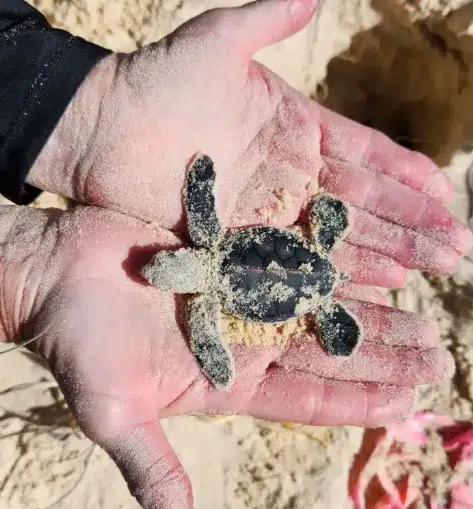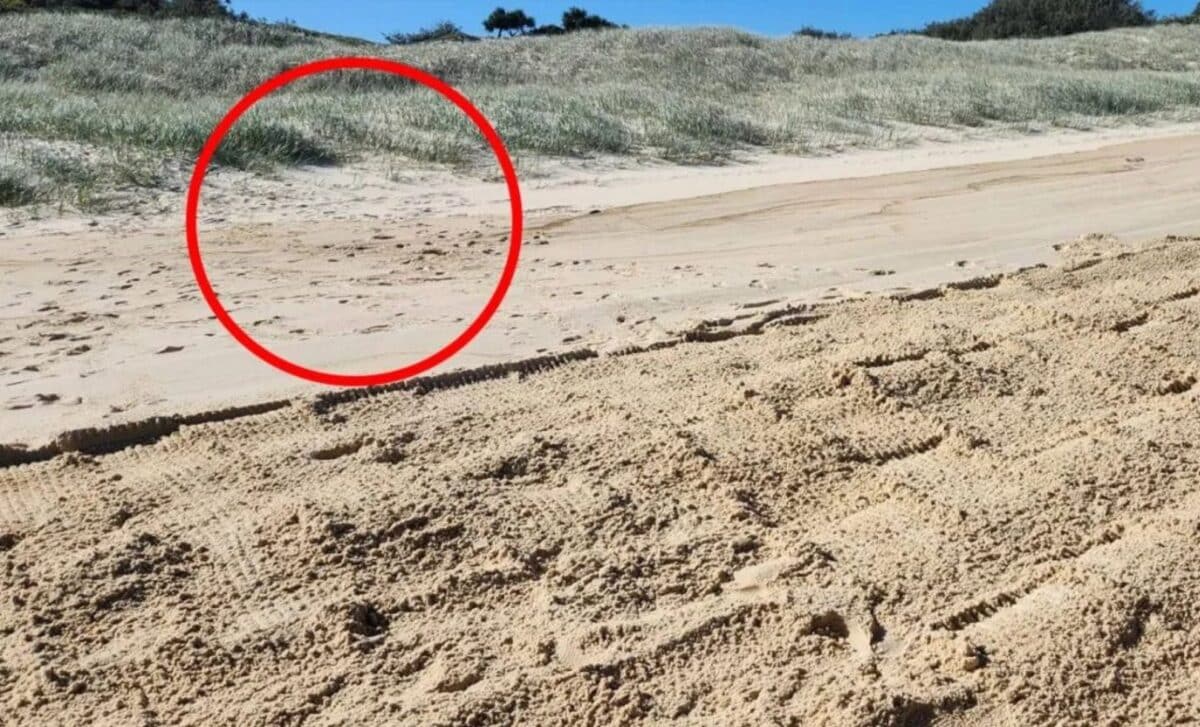On the wind-swept sands of Teewah Beach in Queensland, Australia, a fragile pattern emerged at dawn—tiny, barely perceptible tracks etched into the surface, leading from a small depression in the dunes straight to the ocean. What followed wasn’t just a rare sighting of green sea turtle hatchlings, but the culmination of a season-long conservation effort battling against rising tides, heavy vehicle traffic, and fragmented ecosystems.
Out of 91 eggs laid in a single nest, 85 hatchlings reached the sea—an unusually high success rate for a species still listed as endangered. That outcome didn’t happen by accident. It was the result of meticulous work by Cooloola Coast Turtle Care, a volunteer group that has become a frontline defense against the quiet collapse of nesting habitats along Australia’s increasingly crowded coastlines.
 Teewah Beach, Queensland, Australia. © The State of Queensland (Department of the Environment, Tourism, Science and Innovation)
Teewah Beach, Queensland, Australia. © The State of Queensland (Department of the Environment, Tourism, Science and Innovation)
Their mission, however, is under strain. Four-wheel-drive vehicles dominate much of Teewah Beach, a popular stretch of sand for off-road tourism. Deep tire grooves left by beachgoers often form deadly traps for newborn turtles, steering them inland or exhausting them before they reach the waves. In some cases, vehicles have driven directly over nesting zones, disrupting eggs buried just inches beneath the surface.
Turtles vs. Tires: The Fight for the Beach
Every year, over 30 female green sea turtles return to Cooloola’s coastline to lay their eggs. These nesting sites are critical to the species’ long-term survival. Yet each season, hatchlings must navigate not just natural predators, but a man-made minefield of rutted sand, light pollution, and encroaching human activity.
Cooloola Coast Turtle Care has taken the fight to the sand—literally. Volunteers rake down tire tracks, install temporary markers around nests, and manually guide hatchlings when conditions become too perilous. But the effort is fragile. Some of the barriers were recently removed due to emergency vehicle access concerns, leaving key areas exposed.
 Green Sea Turtle hatchling.
Green Sea Turtle hatchling.
“This isn’t just a beach—it’s a nursery,” said Jan Waters, a lead volunteer on the project. “And we’re asking people to see the coastline not only as a playground, but as a living habitat that’s disappearing faster than we can protect it.”
Their work echoes broader trends across Australia and beyond. The expansion of coastal development and vehicle access points is outpacing regulatory frameworks, according to a recent report from the Australian Marine Conservation Society. It found that uncontrolled beach driving is a leading cause of hatchling mortality in nesting zones across Queensland and Northern New South Wales.
Local Action, Limited Reach
In response to the growing risk, Cooloola volunteers have proposed limiting beach driving to two hours before and after low tide—a move designed to reduce the depth and persistence of tire tracks during high-risk periods for hatchlings. The measure has yet to be formally adopted but has gained some informal traction among returning beachgoers.
In a region where tourism is a pillar of the local economy, the proposal is far from simple. Regulatory jurisdiction falls under both Queensland Parks and Wildlife Service and regional councils, leading to inconsistent enforcement. That vacuum has left much of the burden on community volunteers—many of them retirees—who patrol the beach at odd hours armed with rakes, shovels, and signage.
 Tire tracks during high-risk periods for hatchlings.
Tire tracks during high-risk periods for hatchlings.
“We can’t enforce,” said Waters. “All we can do is educate and adapt.”
Some local authorities have taken note. According to the Queensland Department of Environment, discussions are underway about a collaborative framework for beach driving zones during nesting seasons. In the meantime, volunteer groups are filling the gap left by overstretched wildlife officers and minimal real-time monitoring.
Fragile Success, Systemic Risk
The survival of 85 hatchlings this season is a victory, but one that underscores a sobering reality: the long-term outlook for green sea turtles remains precarious. Hatchlings face only a 1 in 1,000 chance of reaching adulthood under ideal conditions. With additional pressure from climate shifts, ocean pollution, and coastal sprawl, that ratio could worsen.
Experts stress that while community conservation is impactful, it is not a substitute for national-scale habitat protection. “Grassroots efforts are vital,” said Dr. Michael Hamann, a marine ecologist at James Cook University. “But without structured policy intervention, we’re asking too much of too few.”
Teewah’s case isn’t isolated. Globally, nesting grounds for sea turtles—from Florida to Southeast Asia—are shrinking or degraded due to tourism and erosion. Many now require artificial relocation of eggs or labor-intensive protection methods to ensure even minimal hatch rates.
